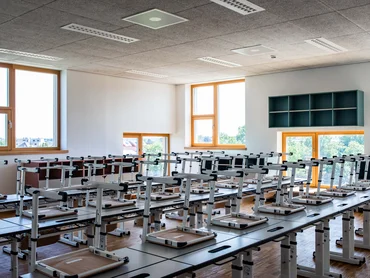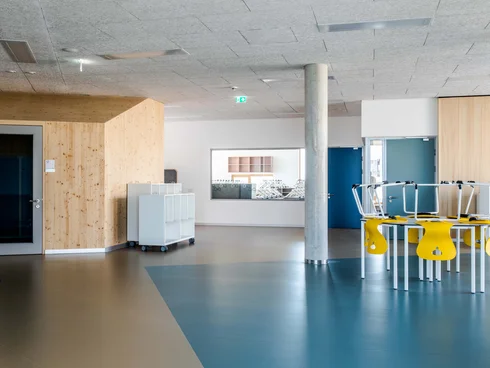Educational campus on Berresgasse
construction
Factbox
Client: CamBerr22 GmbH
Contractor: Porr Bau GmbH
Architect: PSLA ARCHITEKTEN ZT GmbH / Porr Design & Engineering
Contract Type: Generalunternehmer inkl. Ausführungsplanung
Project Type: Building construction
Scope: Construction of an educational campus as a PPP project
Contract Volume: EUR 42.5 m
Construction Start: 10/2017
Construction End: 05/2019
PORR finances, plans, builds, and maintains an educational campus in Vienna-Hirschstetten. The project has a duration of 25 years.
Several PORR departments were involved in the Berresgasse educational campus project. PORR Design & Engineering was responsible for planning, PORR Bau GmbH built the complex, and PORREAL Facility Management is responsible for supervision and maintenance.
The educational campus on Berresgasse in Vienna’s Hirschstetten district was planned and implemented by the City of Vienna as a public-private partnership model. PORR was responsible for the financing, planning, and construction of the project together with PORR Design & Engineering. PORR Bau and will operate the campus with PORREAL for 25 years before it becomes the property of the City of Vienna.
The campus offers children up to the age of fourteen a holistic, integrative educational institution. This includes infant groups, kindergartens, and schools. A triple gymnasium, a band rehearsal room, and outdoor play and sports facilities also offer numerous possibilities for active leisure activities.
PORR secured the contract in a multi-stage award procedure based on the best bidder principle. In addition to the price (which had a weighting of 30%), qualitative criteria were also taken into account.
Planning and rapid implementation
Based on the draft and submission planning of the architectural office PSLA ARCHITEKTEN ZT GmbH, PORR Design & Engineering developed the planning, including structural design and building physics. In order to coordinate the planning process and to better integrate the companies for the building services, PORR relied on the principles of lean management.
This meant that the plans were quickly forwarded to the construction department. Following the operational start of construction in October 2017, the topping out took place in May 2018. A particular challenge proved to be the production of large areas of exposed concrete in winter weather.
All products used had to be durable, easy to clean, and hard-wearing. In the course of sampling appointments, all lead products were scrutinised together with the client, tested for their suitability and, if necessary, replaced by alternative products.
Construction manager, PORR Bau GmbH
Sustainable materials
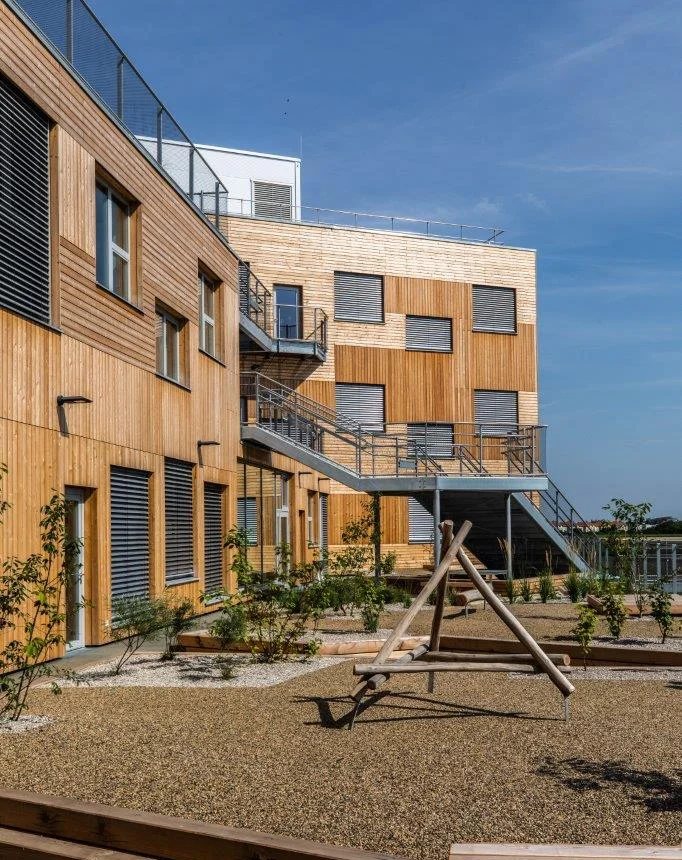
Parallel to the erection of the shell, the first sampling appointments also took place. Together with the City of Vienna and its consultants, the design of the campus was coordinated. The technical properties of the lead products were scrutinised and their suitability was tested. If necessary, they were replaced by alternative products.
All products used have to be durable, easy to clean, and hard-wearing. This high requirement profile can be seen, for example, in the wooden façade that surrounds the building from the 1st floor onwards. This was already agreed in the design phase with Holzforschung Austria and several fire protection experts in order to ensure the best possible drying of the cladding after precipitation and the protection of the 20 cm thick insulation.
During the erection of the support battens, care was taken to prevent fire flashovers. Because of the change from vertical to horizontal planking specified by the architects, this was no small feat. The cladding weathers and greys differently depending on the installation position. The desired appearance will therefore develop over time.
Open alignment through multifunctional areas
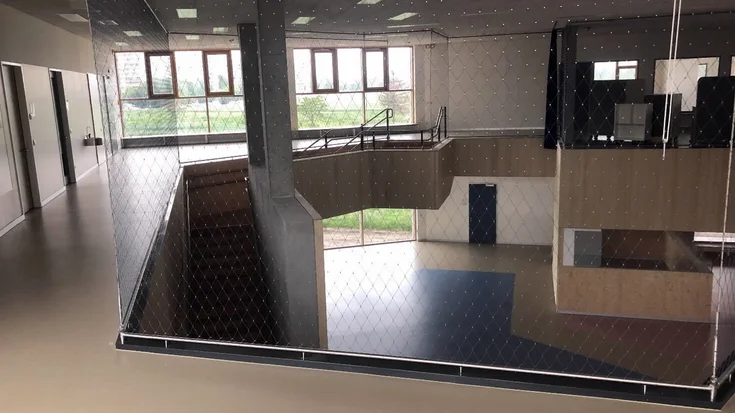
Meeting and communication should be at the centre of the individual education areas. Therefore, all educational spaces are connected by multifunctional areas. This open character can also be seen in the atriums on the second floor, which allow direct visual contact with the floor below. These ceiling openings are secured with room-high, colourful coated stainless steel nets, the substructure of which was elaborately integrated into the ceiling and floor. The mesh size of the nets was designed for the best possible visibility. However, if there is a need for a privacy screen, curtains can be used inside the atriums.
Stoneware tiles were cut using a water jet and assembled into various patterns. A special laying pattern was devised for the remaining pieces. This was used in various sanitary areas.
Construction manager, PORR Bau GmbH
Precise tiling
All sanitary facilities on campus were adapted to the needs of the respective age group. Special attention was paid to the tiling of the development areas. Using a water jet, triangular and trapezoidal parts were cut from stoneware tiles in 30/60 format and assembled into various patterns. A special laying pattern was devised for the remaining pieces. This was used in various sanitary areas. Cutting the tiles using a water jet ensures a cutting accuracy in the range of one tenth of a degree. Appropriate care was then also required when laying the tiles because even the smallest inaccuracies in the surface would be visible immediately.
Gymnasium with a lot of exposed concrete
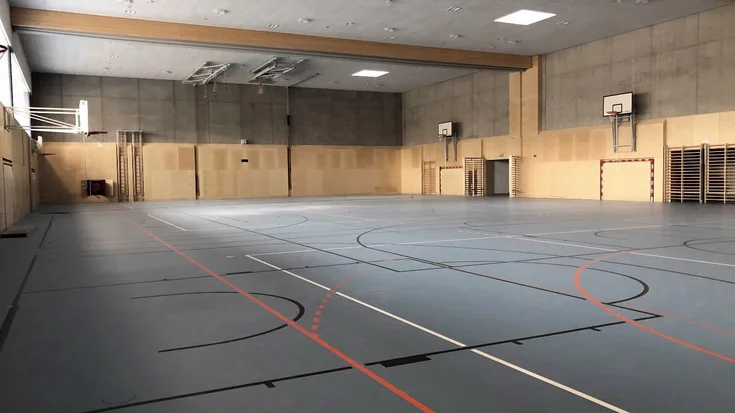
The triple gymnasium extends as a solitary structure over the basement and ground floors and is connected underground to the main building. The gymnasium can be divided into three individual areas using separating curtains. The exterior walls are made of exposed concrete approx. 10.5 m high and up to 50 cm thick; these are clad with a larch wood façade. For the roof construction, four 28 m long glued laminated timber girders were lifted in. Together with the cross beams installed between them, they form the supports for the ceiling made of cross-layer laminated wood. A warm roof with extensive greening was constructed on this. An originally planned photovoltaic system was dispensed with for structural reasons.
Complex logistics
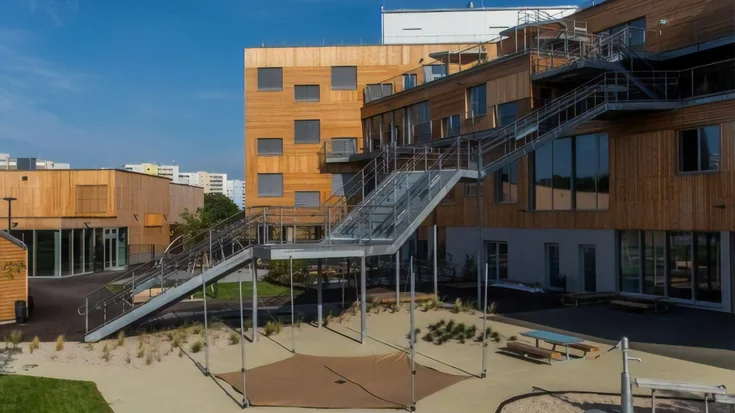
The outdoor facilities, some of which are open to the public, offer play and sports facilities for all ages. The ground plan of the outdoor facility made the construction possible only via the future running track, which was the last to be built. The almost simultaneous production of ethylene-propylene-diene rubber coverings, synthetic resin-bonded high-grade chippings, water-bonded pavements, asphalt surfaces, and green areas therefore had to be precisely coordinated.
Conclusion
In the Berresgasse PPP project, PORR was able to offer all central tasks – from financing to planning to construction – from a single source. Once the construction work has been completed, the building will be handed over to PORREAL at the end of 2019. The campus will be gradually put into operation by the start of the new school year in September 2019.
Technical data
- Property area
approx. 19,070m²
- Excavation volume
approx. 40,000m³
- Gross floor area
approx. 19,280m²
- Excavation depth
up to 7.2m
- Car parking spaces
10
- Asphalt
approx. 2,800m²
- Steel used
approx. 47t
- Concrete used
approx. 14,000m³
- Reinforcing steel used
approx. 1,285t
